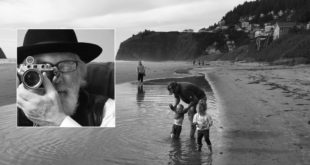At 97 years old, Helen Dalgleish is easily the oldest artist we have featured on InSpire. Although she admits to slowing down in the last few years, Helen was extraordinarily prolific during her painting heyday and continues to create her colorful and elegant works to this day. Currently a resident of a retirement community in Loma Linda, California, Helen is surrounded by hundreds of watercolors, oils, acrylics, block prints, serigraphs and drawings, most of which are hers. Some, however, are the work of her late husband, Dr. Arthur Dalgleish, and at least one image is the work of the couple’s artistic mentor, the late Vernon Nye. We recently caught up with Helen to talk about her life, art and motivation.
(The following interview was conducted. by James Ponder in Loma Linda).
JP – Helen, over the course of your life you have created a large body of beautiful art. Why do you paint?
Helen – Why do I paint? During the Great Depression of the 1930s, President Franklin Delano Roosevelt initiated a nationwide work program — the Works Progress Administration — to put Americans back to work and stimulate the economy. Among those jobless people were artists, some of whom offered free art classes in San Bernardino, California, the town where I lived. My parents saw the announcement in the newspaper and urged me to enroll. I was 11 years old when I started attending those classes. I roller-skated seven blocks from our home to the Municipal Auditorium, where the classes were held. I was so thrilled with what I was learning that I attended art classes each summer for three years! Those were happy, carefree hours learning to draw and paint from my teacher, Miss Effie Phelps. This was the beginning of my art journey, and my interest in it has not diminished.
JP – So it all started when you were 11. Did you ever paint professionally?
Helen – No, not really, it was just something I always loved to do on the side. I did do some technical pen drawings for the Loma Linda University audiovisual department in the mid-1970s, but I never painted professionally. In the 1950s, when my two children were of elementary-school age, I worked part-time as a bookkeeper and took art classes at nearby San Bernardino Valley College. As they got older, I worked full-time for several years as a department secretary at Loma Linda University. After my children became adults and left home, I pursued my dream of obtaining a college degree. I was almost 50 when I earned a BA degree in fine arts and a provisional certificate to teach K-12. However, I chose not to teach, but rather to work as an administrative secretary. I spent my final years of employment as an administrative assistant in a financial department at LLU.
JP – So from the paintings hanging on your walls, it looks like you and your husband painted together quite often. You have pieces that look like they were created in the very same place, perhaps even on the same day, from different viewpoints and minor stylistic differences. Was he ever a professional artist?
Helen – No, he wasn’t, either. My husband began his career as a teacher in the SDA school system and taught grades six through 10 for eight years before he began working toward a PhD in anatomy. After graduation, he was invited to join the staff of the anatomy department at Loma Linda University as an associate professor. But he always loved art and we painted together in many different places over the years.
JP – A lot of your paintings look like they were created in Northern or Central California. Were those your favorite places to paint?
Helen – Yes, I would say so. After Arthur and I retired, we attended summer watercolor workshops conducted by Dr. Vernon Nye at the Pacific Union College field station at Albion, California, We went out to different places along the Pacific Coast each day and painted en plein air in watercolor. These workshops grew into yearly reunions with Dr. Nye and friends, and became so much a part of our lives that we eagerly looked forward to returning year after year. We did that for 16 years, and as a result, most of my early watercolors were of coastal scenery. I especially enjoyed painting near Mendocino.
Also during our retirement years, we became members of Yosemite Western Artists, an art organization near our home in Coarsegold, California. We often entered paintings in the annual Tri-County Art Exhibit. We won several awards. After Arthur died in 2013, I moved to Southern California and joined the local art club, Loma Linda Art Association. I’ve entered several of their spring and fall art competitions and won a few awards for some of my entries.
JP – Talk about your approach to painting. What kinds of materials do you like to work with, and how do you go about creating a work of art?
Helen – Over the years, I’ve enjoyed working in different media and experimenting with a variety of styles. My main focus, however, has always been experimenting with watercolors. Sometimes I approached a painting with spontaneity and flexibility, hoping it would turn into a happy accident. But more often, I found that an analytical and disciplined approach helped me work out the details of a difficult problem. Capturing the beauty of flowers fresh from the garden has become my most recent interest. I’ve always been fascinated by creating abstract designs derived from the natural environment. But my interest in developing my skills to create beautiful pictures has been a lifelong passion. Hopefully, they also bring happiness and pleasure into the lives of others as well.
JP – How does your art interface with your spirituality?
Helen – During the early years of my adulthood, I had the impression that Christianity did not embrace the subject of art as important to church life. Art was never included, for instance, in the curriculum of the Adventist school or academy I attended. I am so thankful for the free WPA summer art classes I had as a child! In later years, I began to notice a shift in the attitude of church-based schools towards the arts.
JP – Yes, I share your enthusiasm for the change. I recently traveled to eight Adventist schools in the Pacific Union and was delighted to learn that art is now a prominent feature of the curriculum along with religion and STEM — science, technology, engineering and mathematics — courses. But I digress. Please continue.
Helen – That’s good to know. I was glad for the opportunity to go back to an Adventist college to study art when I was middle-aged. Good art programs were developed for the benefit of many artistically talented people. It was brought to our attention that we could call our Lord Jesus Christ the Master Artist because in the beginning He was the Creator of this world and He created it with such beauty and perfection. I now believe it gives Him great pleasure to see His children enjoying the beautiful things He created for their benefit. Spending time in the garden with lovely flowers or the wide, open spaces with our canvases, paint boxes or cameras opens the opportunity to see beyond the boundaries or our selves and become in tune with God.
JP – Thank you so much, Helen, for sharing your story as well as your passion for painting with us.
Visit Helen’s online gallery.
© 2017 - 2024 ASA. All rights reserved. Click here for content usage information.



